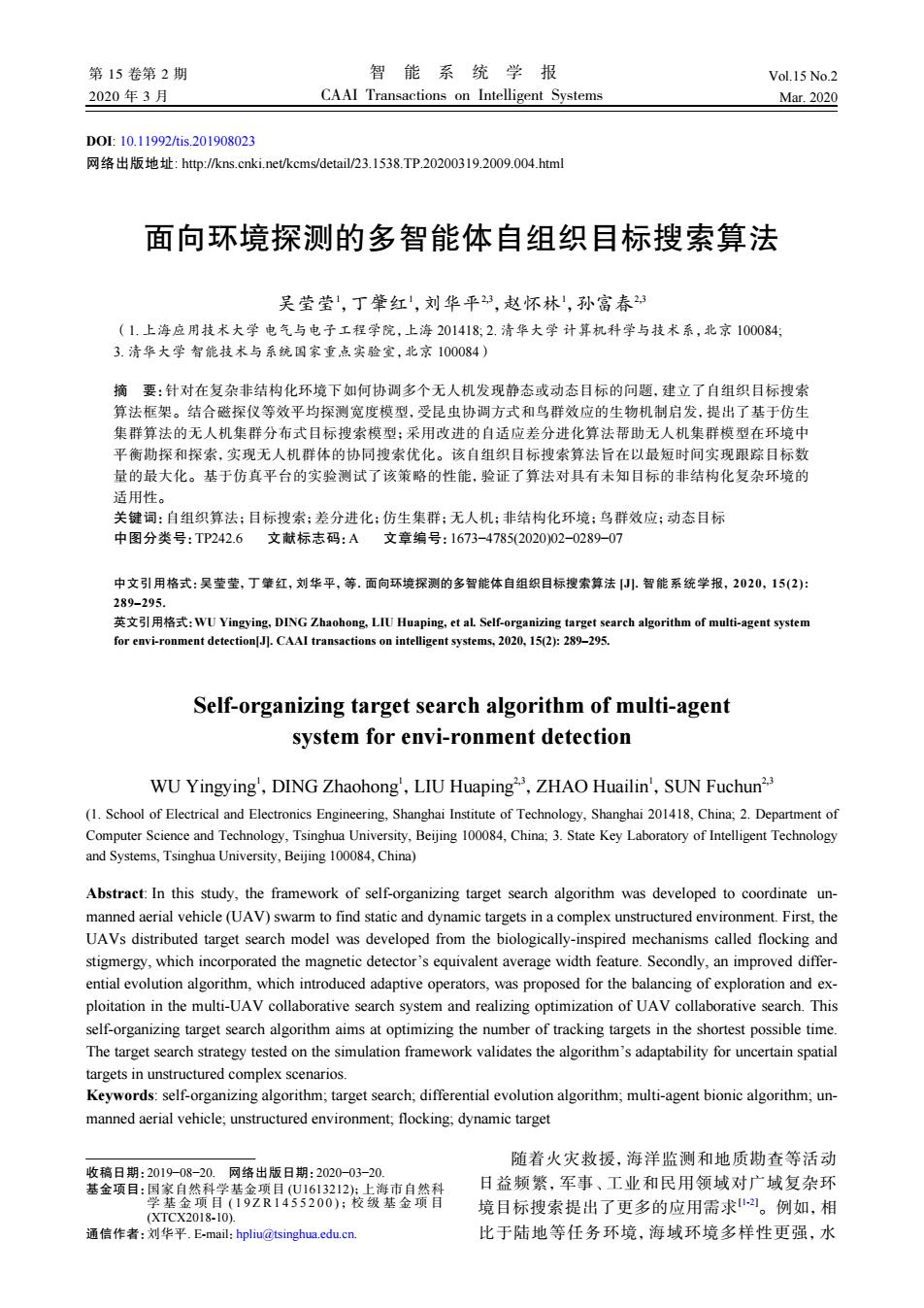正在加载图片...

第15卷第2期 智能系统学报 Vol.15 No.2 2020年3月 CAAI Transactions on Intelligent Systems Mar.2020 D0:10.11992tis.201908023 网络出版地址:http:/kns.cnki.net/kcms/detail/23.1538.TP.20200319.2009.004html 面向环境探测的多智能体自组织目标搜索算法 吴莹莹,丁肇红',刘华平,赵怀林,孙富春 (1.上海应用技术大学电气与电子工程学院,上海201418,2.清华大学计算机科学与技术系,北京100084; 3.清华大学智能技术与系统国家重点实验室,北京100084) 摘要:针对在复杂非结构化环境下如何协调多个无人机发现静态或动态目标的问题,建立了自组织目标搜索 算法框架。结合磁探仪等效平均探测宽度模型,受昆虫协调方式和鸟群效应的生物机制启发,提出了基于仿生 集群算法的无人机集群分布式目标搜索模型:采用改进的自适应差分进化算法帮助无人机集群模型在环境中 平衡勘探和探索,实现无人机群体的协同搜索优化。该自组织目标搜索算法旨在以最短时间实现跟踪目标数 量的最大化。基于仿真平台的实验测试了该策略的性能,验证了算法对具有未知目标的非结构化复杂环境的 适用性。 关键词:自组织算法;目标搜索;差分进化:仿生集群;无人机;非结构化环境:鸟群效应;动态目标 中图分类号:TP242.6文献标志码:A 文章编号:1673-4785(2020)02-0289-07 中文引用格式:吴莹莹,丁肇红,刘华平,等.面向环境探测的多智能体自组织目标搜索算法.智能系统学报,2020,15(2): 289-295. 英文引用格式:WU Yingying,.DING Zhaohong,LIU Huaping,etal.Self-organizing target search algorithm of multi-agent system for envi-ronment detection[J].CAAI transactions on intelligent systems,2020,15(2):289-295. Self-organizing target search algorithm of multi-agent system for envi-ronment detection WU Yingying',DING Zhaohong',LIU Huaping2,ZHAO Huailin',SUN Fuchun2 (1.School of Electrical and Electronics Engineering,Shanghai Institute of Technology,Shanghai 201418,China;2.Department of Computer Science and Technology,Tsinghua University,Beijing 100084,China;3.State Key Laboratory of Intelligent Technology and Systems,Tsinghua University,Beijing 100084,China) Abstract:In this study,the framework of self-organizing target search algorithm was developed to coordinate un- manned aerial vehicle(UAV)swarm to find static and dynamic targets in a complex unstructured environment.First.the UAVs distributed target search model was developed from the biologically-inspired mechanisms called flocking and stigmergy,which incorporated the magnetic detector's equivalent average width feature.Secondly,an improved differ- ential evolution algorithm,which introduced adaptive operators,was proposed for the balancing of exploration and ex- ploitation in the multi-UAV collaborative search system and realizing optimization of UAV collaborative search.This self-organizing target search algorithm aims at optimizing the number of tracking targets in the shortest possible time. The target search strategy tested on the simulation framework validates the algorithm's adaptability for uncertain spatial targets in unstructured complex scenarios. Keywords:self-organizing algorithm;target search;differential evolution algorithm;multi-agent bionic algorithm;un- manned aerial vehicle;unstructured environment;flocking;dynamic target 随着火灾救援,海洋监测和地质勘查等活动 收稿日期:2019-08-20.网络出版日期:2020-03-20. 基金项目:国家自然科学基金项目(U1613212):上海市自然科 日益频繁,军事、工业和民用领域对广域复杂环 学基金项目(19ZR1455200):校级基金项目 境目标搜索提出了更多的应用需求。例如,相 (XTCX2018-10). 通信作者:刘华平.E-mail:hpliu(@tsinghua.edu.cn 比于陆地等任务环境,海域环境多样性更强,水DOI: 10.11992/tis.201908023 网络出版地址: http://kns.cnki.net/kcms/detail/23.1538.TP.20200319.2009.004.html 面向环境探测的多智能体自组织目标搜索算法 吴莹莹1 ,丁肇红1 ,刘华平2,3,赵怀林1 ,孙富春2,3 (1. 上海应用技术大学 电气与电子工程学院,上海 201418; 2. 清华大学 计算机科学与技术系,北京 100084; 3. 清华大学 智能技术与系统国家重点实验室,北京 100084) 摘 要:针对在复杂非结构化环境下如何协调多个无人机发现静态或动态目标的问题,建立了自组织目标搜索 算法框架。结合磁探仪等效平均探测宽度模型,受昆虫协调方式和鸟群效应的生物机制启发,提出了基于仿生 集群算法的无人机集群分布式目标搜索模型;采用改进的自适应差分进化算法帮助无人机集群模型在环境中 平衡勘探和探索,实现无人机群体的协同搜索优化。该自组织目标搜索算法旨在以最短时间实现跟踪目标数 量的最大化。基于仿真平台的实验测试了该策略的性能,验证了算法对具有未知目标的非结构化复杂环境的 适用性。 关键词:自组织算法;目标搜索;差分进化;仿生集群;无人机;非结构化环境;鸟群效应;动态目标 中图分类号:TP242.6 文献标志码:A 文章编号:1673−4785(2020)02−0289−07 中文引用格式:吴莹莹, 丁肇红, 刘华平, 等. 面向环境探测的多智能体自组织目标搜索算法 [J]. 智能系统学报, 2020, 15(2): 289–295. 英文引用格式:WU Yingying, DING Zhaohong, LIU Huaping, et al. Self-organizing target search algorithm of multi-agent system for envi-ronment detection[J]. CAAI transactions on intelligent systems, 2020, 15(2): 289–295. Self-organizing target search algorithm of multi-agent system for envi-ronment detection WU Yingying1 ,DING Zhaohong1 ,LIU Huaping2,3 ,ZHAO Huailin1 ,SUN Fuchun2,3 (1. School of Electrical and Electronics Engineering, Shanghai Institute of Technology, Shanghai 201418, China; 2. Department of Computer Science and Technology, Tsinghua University, Beijing 100084, China; 3. State Key Laboratory of Intelligent Technology and Systems, Tsinghua University, Beijing 100084, China) Abstract: In this study, the framework of self-organizing target search algorithm was developed to coordinate unmanned aerial vehicle (UAV) swarm to find static and dynamic targets in a complex unstructured environment. First, the UAVs distributed target search model was developed from the biologically-inspired mechanisms called flocking and stigmergy, which incorporated the magnetic detector’s equivalent average width feature. Secondly, an improved differential evolution algorithm, which introduced adaptive operators, was proposed for the balancing of exploration and exploitation in the multi-UAV collaborative search system and realizing optimization of UAV collaborative search. This self-organizing target search algorithm aims at optimizing the number of tracking targets in the shortest possible time. The target search strategy tested on the simulation framework validates the algorithm’s adaptability for uncertain spatial targets in unstructured complex scenarios. Keywords: self-organizing algorithm; target search; differential evolution algorithm; multi-agent bionic algorithm; unmanned aerial vehicle; unstructured environment; flocking; dynamic target 随着火灾救援,海洋监测和地质勘查等活动 日益频繁,军事、工业和民用领域对广域复杂环 境目标搜索提出了更多的应用需求[1-2]。例如,相 比于陆地等任务环境,海域环境多样性更强,水 收稿日期:2019−08−20. 网络出版日期:2020−03−20. 基金项目:国家自然科学基金项目 (U1613212);上海市自然科 学基金项 目 (19ZR1455200) ;校级基金项 目 (XTCX2018-10). 通信作者:刘华平. E-mail:hpliu@tsinghua.edu.cn. 第 15 卷第 2 期 智 能 系 统 学 报 Vol.15 No.2 2020 年 3 月 CAAI Transactions on Intelligent Systems Mar. 2020